What I’ve Been Playing (Q1) 2019 Wrap-up
A summary of the games I’ve been playing during the first quarter (Q1) of the year (January-March).
 UnexpectedGames
UnexpectedGames
Just a friendly bear who works in financial reporting that would rather be playing, writing or talking about video games. https://twitch.tv/unexpectedenemy
A summary of the games I’ve been playing during the first quarter (Q1) of the year (January-March).
The new year is a time for reflection, better choices, new year’s resolutions and all that jazz. For me, it’s a time of mental fortitude and a willingness to power-through life’s immortal enemy; work. From January through March, my personal/gaming time is severely limited due to my profession, however, this isn’t my first rodeo. As I enter my 7th season/year in the financial services/hedge fund industry, I’ve grown to make better use of my time, yet there’s always something that falls by the wayside. On the gaming-front, a fresh new year is an opportunity to start brand new games, close-out ones that have been in-progress and restart my annual goal of “52 games completed” (which you can participate in here).
GRIS, developed by Nomada Studio, is a short & sweet puzzle-platformer with a beautiful hand-drawn aesthetic. Games like Braid, Limbo and INSIDE have popularized and reignited the 2D “art-formers” of yesterday and classics like Another World, Prince of Persia, Heart of Darkness and even Abe’s Odyssey/Exodus paved the way for what a lot of indie studios are achieving today, GRIS included. Despite its strong emphasis on narrative and storytelling through art and minimalism, GRIS is a lot more game-y than I was expecting it to be. GRIS is an abstract journey which depicts a female character who’s lost her voice and the trials & tribulations one must go through to find one’s self-worth (or that’s what I’ve gathered at least as the game has virtually zero dialogue).

In a Metroid-like fashion, the game is centered around an interconnected hub, which evolves as the player unlocks new abilities and completes each of the areas that branches from it. Every level is thematically unique, both in its visual presentation and gameplay mechanics. In one world, for example, the player obtains the ability to become a block, which allows one to break through certain environmental pieces or solve puzzles. The game doesn’t overstay its welcome, either. Each world is relatively linear, but some levels do allow certain objectives to be tackled in a non-linear fashion. My biggest disappointment with the game, however, is that you cannot backtrack to older areas, but there is a chapter select which gives the player an opportunity to discover any missed secrets (which there are a handful to be discovered).

I completed the game in two or three sessions on my Nintendo Switch, but I’ve yet to find all the hidden items or unlock the secret challenges. I will likely go back and complete the game at 100%, but I’m in no rush to return to the experience anytime soon. Although GRIS is a beautifully animated journey, it didn’t quite deliver the hard & heavy emotional gut-punch I was hoping it would. I would certainly recommend it to those who enjoy a lot of the aforementioned 2D puzzle-platformers, but it didn’t have the same impact on me as games like INSIDE or The Missing: J.J. Macfield and the Island of Memories.
Black Bird, developed by Onion Games, and from the visionary mind behind such titles as Chulip, Little King’s Story (a personal favorite of mine) and Rule of Rose, comes a side-scrolling shooter that pays homage to the classic arcade shooter, Fantasy Zone. Onion Games is a Japanese independent studio consisted of a handful of industry veterans, including Yoshiro Kimura, Kazuyuki Kurashima and Tom Ikeda. While their previous games have been exclusive to mobile devices, Black Bird is Onion Game’s first console/PC debut and boy is it one weird game! One could say that Black Bird’s presentation evokes a silent film from the 1920s, complete with the film graininess and strange vignettes between stages that one would expect. There’s no spoken dialogue, but the game appears to portray the life of an orphaned girl whose parents were killed in gruesome accidents (or even murdered?).
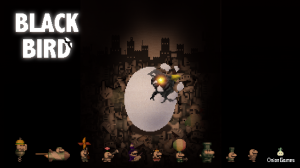
After the girl appears to be shied away from an orphanage, the little one collapses and a man with a cane turns her into an egg, which ultimately hatches and becomes a disembodied crow-like head that wrecks havoc on the inhabitants of what appears to be a European-styled town. It’s dark and disturbing yet nonetheless charming due to its cute sprites, strange denizens and enemies that animate, dance and march throughout the city streets. The player can fly left or right and the stage will loop until all target enemies (towers) are eliminated. Each level culminates in bizarre boss battles, which are supposed to resemble the things/people who have scarred/harmed the girl from her past. The game is also relatively short, but it is meant to be replayed as there are multiple endings based on certain max/total score thresholds. In each level, there are hidden characters to shoot for bonus points and opportunities to earn more health, screen-clearing bombs and speed power-ups (which make the player move faster).

Black Bird’s got traditional “shmup/STG” mechanics at its core, but everything melds together rather nicely. It seems like completing each stage quickly while using bombs at max score multiplier is the intended way to play, as the “True Ending” is quite difficult to achieve if you don’t know the game/enemy patterns by heart. It’s not the easiest shooter, either. There are no lives/continues, however, the crow’s hit-box is rather small and there are plenty of opportunities to stock extra health, bombs and the like. There’s a nice risk/reward system at play here, too. Play defensively and hoard bombs/health to survive or play aggressively (yet smart) in order to climb the leader-boards and earn the coveted best ending. Good stuff! I completed the game a few times (including its True Mode), but have yet to earn the best ending (which I believe requires 25,000,000 points). Practice! Practice! Practice!
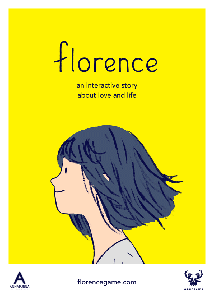
Florence, developed by Australian studio, Mountains, and published by Annapurna Interactive (a company that is slowly becoming the de-facto house for quality indie titles), is an extremely breezy short-story/visual novel for mobile devices. The game centers around a woman’s day-to-day life and the personal struggles she experiences as one enters adulthood. Florence depicts the life of two individuals whose hopes and dreams become sidelined as life and love “get in the way”, so to speak. What’s interesting about Florence (similar to Black Bird and GRIS) is that there’s no spoken dialogue. Everything is communicated to the player visually and the conversations between the two main characters are presented by puzzle-pieces.

It’s a clever mechanism to deliver a narrative, as communication is often confusing and sometimes words don’t quite connect the way they are supposed to, especially when emotions are involved. The game itself utilizes basic touch-screen maneuvers/controls (such as tapping and swiping), yet it’s all rather intuitive. In some chapters, the player will have to brush their teeth by swiping a digital toothbrush from left to right, tap on colors/prints to customize a butterfly or unpacking their significant other’s belongings by dragging and dropping certain items into a storage box. It sounds simple and boring, quite like life, right? The game elevates these mundane tasks and life moments through its beautiful visual presentation and music, however. I completed the game in about an hour on a 4-hour flight and had plenty of time to fart around on my phone or play something else afterwards.
While February is a short month, it’s also an extremely busy time of the year for me. As I mentioned in my January post, due to my field of work, the first quarter of the year severely hampers my ability to play games. February is when my season hits its stride, so it’s probably the one month out of the year where I barely accomplish anything gaming-related (next to March). With that said, despite my reservations and general resistance to mobile gaming, I’ve found that playing certain games on my phone during my downtime at work is the only opportunity I have to even attempt to finish a game from my backlog. I’m also going to rate each mobile game based on how well suited they are for discreet work-play (please don’t tell my boss!).
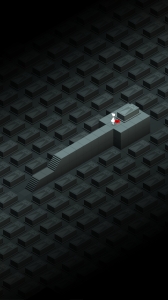
Monument Valley, developed by Ustwo Games, is an isometric, minimalist puzzle game for mobile devices. Players must guide a nondescript figure through a series of monuments in order to reach their goal. To accomplish this, one must manipulate each object by twisting and turning certain pieces in order to solve perception-based puzzles. At times, Monument Valley feels like an interactive, abstract painting due to its colorful palate and mysterious undertones. There’s a light story being told here as well, but it’s delivered in cryptic messages between levels, which drives the little narrative that’s there forward. While I completed the game a year or two ago, I never did finish its DLC, the Forgotten Shores and IDA’s Dream. I decided to replay the original content in addition to the DLC and after a few short sessions at work, I completed everything there was to do and unlocked all of the achievements, too.
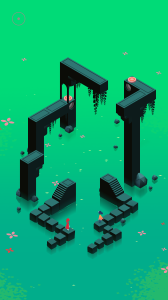
Its sequel, Monument Valley 2 (MV2), feels like more of the same, yet it presents a much stronger narrative this time around. MV2 appears to be telling the story of a parental figure and a child as they explore the monuments that lie before them. There’s a more cinematic approach to the stage design, as well as a few dramatic set-pieces sprinkled throughout the levels. In general, both MV titles have been the perfect games to play at work. In-between my work responsibilities, I would find myself looking down at my phone, studying the landscape, making a few moves and pondering the next solution to the stage, all the while listening to its relaxing, ambient music (composed by the wonderful Todd Baker). Both MV titles have quickly become some of my favorite mobile games and I’d pick-up ports of these two classics on the Nintendo Switch in a heartbeat!
Monument Valley 1 & 2 / On-the-Job \ Recommended!
Both Monument Valley 1 & 2 are the perfect games to play at work, especially if you have an office/desk job (like me!). Put some headphones on (if you’re allowed) and drown at the noise of your co-workers while you listen to relaxing, ambient music. I was able to manage my daily responsibilities while occasionally looking down at my phone to make my next move. Whether it was a simple rotation to change the perspective of the monument or a tap of the screen to move the little-guy towards its next destination, MV 1 & 2 are quintessential at-work games!
The Room, developed by Fireproof Games, is a single-screen, point & tap puzzle game where the goal is to unlock the secrets to a Jigsaw-like box. The game takes place in an undisclosed location and the box you’re trying to unlock sits suspiciously in the attic of what appears to be an abandoned house. Who you are playing as is unclear at first, however, the game slowly unfolds its story as the player progresses. While there’s an extremely light narrative told through the usage of notes scattered about the box, the core of the game is that of an extremely dense puzzle-simulator. Players can swipe the screen to rotate their perspective while zooming in/out of the box in order to solve the various puzzles that lie before them. I liken the whole experience to one big Resident Evil (RE) puzzle. Similar to the classic RE games, the player can examine, inspect and rotate keys and other objects to solve riddles. I’ve completed the main game with no hints/walkthroughs (which I feel relatively proud about), but there’s an epilogue mode I’ll tackle next.
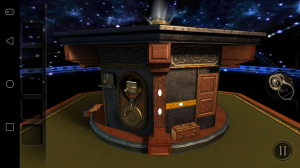
The Room / On-the-Job \ Recommended!
Not to be mistaken by the best/worst movie of all time (The Room), The Room is well-suited for the day-to-day office-life doldrums. Similar to both Monument Valley games, The Room is also a low-key, idle-at-my-desk phone application. I found myself looking down at my phone, studying the box and its contraptions (while listening to the ambient sounds and creepy floor squeaks) only to find myself becoming lost in my work while thinking of the next solution. Highly recommended if you consider yourself an expert ponderer of things!
Having finally played through and enjoyed Onion Game’s Black Bird last month, I immediately looked-up their prior releases to see what they may have worked on before. Little did I know that they were responsible for two of the most quirky, yet irresistibly charming mobile games I’ve ever played. Both Dandy Dungeon: Legend of Brave Yamada & Million Onion Hotel (along with Black Bird) appear to be a part of some strange unofficial onion-verse (a term I have coined, thank you), as reoccurring characters, sprites and strange undertones appear and are present throughout all three games.
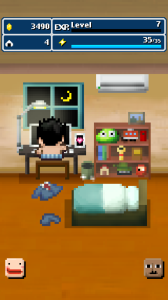
Dandy Dungeon is one-half game-dev simulator, another half dungeon crawler and one big existential crisis! The game portrays the life of an up & coming programmer who, in his spare time, codes his very own indie game (alone in his apartment dressed in nothing but a pair of boxers mind you) in order to win the affection of his neighbor. It’s quirky, weird, yet extremely charming. The game itself is a pseudo rouge-like RPG in the same vein as say Spike Chunsoft’s Shiren the Wanderer or Namco’s Tower of Druaga. Based on the experiences Yamada has with his friends, neighbors and co-workers, he will implement new ideas into his game, which bring about new gameplay mechanics when venturing into the game’s numerous dungeons. There are also extremely funny, well-written scenes between each stage that pushes the charming, yet sometimes creepy story forward.

The dungeons are comprised of single-screen floors, which must be navigated by tracing a line and creating a path across the tiles with your finger. If the player manages to route a path through the floor in one-fell swoop, they’ll receive a bonus at the end of the dungeon, too. Combat is also turn-based and the player can arm themselves with equipment (of which can be upgraded with materials) and items they procure from each level. For a simple mobile game, there’s a surprising amount of depth and given that its online functionalities have been disabled at the time of writing this, the game’s kind of beginning to be ported to a new platform. Well, we’re in luck! Dandy Dungeon is coming to the Nintendo Switch (presumably with all of its online functionality in tact), so there’s no excuse not to support Yamada and his humble journey for love, recognition and fortune.

Onion Hotel, on the other hand, is a very hard game to describe. Although I’m relatively unfamiliar with the sub-genre, glorified tapper-games (or what are commonly known as “clickers”), have been prevalent on the mobile scene for quite some time. Onion Hotel is another point & tap game where the goal is to clear screens in a timely manner while maximizing your score. It sounds simple at first, but there’s actually a ton of nuance and depth available for those who choose to play the game beyond a few quick sessions. Each stage is comprised of a series of increasingly difficult levels played on a 5×5 grid. Players must tap onions and other strange creatures that pop-up to earn points. When a square on the grid is tapped, it turns red and when a line is formed, the player earns a time bonus. Clear two lines at once and yell “BINGO!” Actually, that’s not the case. Instead, the player enters a special state and the opportunity to earn even more time, points and special onion knights (which are used during the boss phase) presents itself.
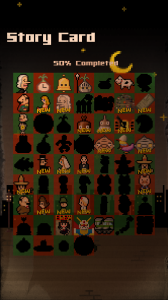
Onion Hotel, at times, feels like some strange variant of whack-a-mole. As bosses are defeated, new enemies are introduced (which take additional taps to remove) and other traps and oddities spring-up from the grid. These obstacles prevent the player from creating those much sought-after single/double line-clears, too. In addition to these new variables, there’s also a handful of silent vignettes sprinkled between the stages. There’s an attempt at a story here, but it’s weird, mature and surprisingly graphic. One minute a man and a woman are having dinner at a classy joint (presumably the hotel), the next minute they’re sleeping together only to be interrupted by some turf-war between the military and FBI. Shots are fired, there’s blood and failing heart-beats trigger remote rocket ships that destroy the very same hotel you’re presumably managing. Need I remind you this is a mobile game? I’ve nearly completed the game (I think…), but the final boss is extremely difficult and I’ve only managed to reach him once so far!
Dandy Dungeon On-the-Job: Recommended!
Million Onion Hotel On-the-Job: Not Recommended!
Dandy Dungeon is another perfect game to play at the office. Similar to the aforementioned titles, Dandy lends itself to idle busy-work. You can easily enter a dungeon, plan a path in your head and take things at your own pace without risking getting caught by your peers. Onion Hotel, however, is NOT a good game to play at work. As you reach the higher levels of the hotel, the game becomes a frantic double-tapping mess of an experience that will surely raise some eye-brows from your fellow co-workers. If you need to play the game at work (as I completely understand its appeal), take it to the bathroom/break-room if you must!
March is usually the most difficult time of the year for me to complete a game. In my field of work, it’s the final push before my busy season is technically “over”. While I was fortunate to have a Saturday or two off during the last few weeks of the month, my obligation towards Destiny 2 (compounded by the little time I had to dedicate towards gaming), once again, prohibited me from making any sort of significant progress in any other game. Due to my schedule, however, I’ve been able to focus/prioritize a few chapters, stages or missions from a handful of games on my weekends. It’s been a slow & steady race to finish some of the games I’ve started in 2019, but satisfying nonetheless.
It blows my mind that the original The Shadow of the Colossus released back in 2005. It was such an ambitious game for its time and it still holds up remarkably today. The 2018 remaster is a sight to behold, too. The animators at Japan Studio/Team ICO are some of the best in the business and the folks over at Bluepoint Games did wonders with this release. I completed the game on Hard difficulty and although I’m tempted to tackle the time trials and uncover the rest of the secrets, I’ll likely retire the game for now. Revisiting this game again provided a newfound appreciation for taking down each colossi. One colossi in particular was a giant (enemy) crab-like monstrosity. The way this colossi tumbles over when its balance is thrown off, how the creature shuts its eyes on impact and the way it contorts on its back, you can really feel the anguish of the beast. It’s beautifully tragic and mesmerizing, to say the least. I’ve played this game to death back on the PlayStation 2 (PS2), but I’m just now revisiting the remake as of 2019. The Shadow of the Colossus is truly a classic.
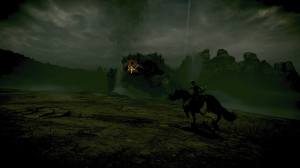
Most people are either still playing Kingdom Hearts III (KH III) or they’ve gotten it out of their system. I’m in neither camp. As someone who’s only ever finished the original game back on PS2 and Birth By Sleep on PSP, I’ve been taking this opportunity to catch-up on the “essential” entries in order to appreciate KH III for all of its convoluted-ness and then-some. I re-played the original KH last year from the KH HD 1.5+2.5 Remix collection on PS4, so I decided to start the next game in the franchise. As of February, I finally completed Sora’s campaign in Kingdom Hearts Re: Chain of Memories (KH Re: CoM). After 20+ hours on Proud difficulty, I can say that it was an interesting experience (arguably more enjoyable than revisiting the first KH), but not something I would consider replaying anytime soon (outside of going for 100% on my current save or checking-out Riku’s side of the story).

KH Re: CoM is a 3D remake of the original sprite-based Game Boy Advance (GBA) game that heavily borrows/utilizes assets from the original PS2 KH game. Each world from the original KH game has been distilled into a series of rooms comprised of enemy encounters, traps and other goodies. Instead of being a straight-up action-RPG, CoM also utilizes an active card-based battle system. Cards can be used both in battle and outside of combat, too. Players can form decks based on their max “CP” limit (which can be increased at level-ups). Certain card combinations can also create sleights, which are more powerful abilities that can cause devastating results. Finally, special “room” cards are used to navigate each world, as new rooms are gated by a specific cards and their numerical value/color. Since all combat/room cards are numbered, each room requires a number equal or greater than a particular value, which are also divided into three distinct colors (red, green and blue).
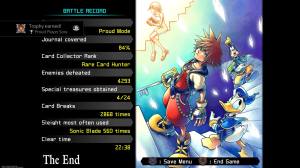
Room cards are interesting because not only are they assigned a value/color, but their descriptions dictate the type of room that you’re going to create. Room cards come in all types/sizes too, including ones that can be comprised of overly aggressive heartless, encounters where enemies are sleeping at the start of battle and others that can even be beneficial like save-points or treasure rooms. It’s all rather overwhelming at first, but after a few hours, the various gameplay systems become easier to grasp. The one thing that stood out to me the most about CoM is the progression through each world. Compared to the original game (where players had to run back and forth, talking to NPCs in order to trigger events/sequences that weren’t particularly clear to the player), CoM was relatively down-to-business. I will likely go back and finish Riku’s side of the story over the summer. There’s only 3.8 games keeping me from starting Kingdom Hearts III now…
Although I’ve written about my experience with Yakuza games before, there was a time when I was up-to-date with the franchise. The western localization was agonizing between Yakuza 4 and 5 and the time between Yakuza 5 and Zero was rather significant, too. That’s not the case today, as both Sega and Ryu Ga Gotoku Studio have been releasing the games in the west at a steady pace. I finally got around to finishing Yakuza 0 last year, so I decided to start Yakuza Kiwami in 2019. I’m currently playing on Hard difficulty and I’m up to Chapter 5 at the moment. I’ve generally been following the main story quests (because I really want to start Kiwami 2 and Yakuza 6), but it’s hard to keep myself from all of the goofy sub-stories and side-activities, even if they’re largely the same as they’ve always been in previous games.
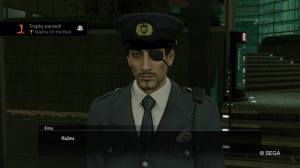
As someone who’s played the original PS2 version of Yakuza, Kiwami has been an interesting experience so far for a variety of reasons. While the game is more or less a retelling of the story from the original game, the developers have released a prequel title since, which has been integrated back into the first game’s scenario. Certain scenes and story beats have been re-written to take Yakuza 0 into consideration, which makes it almost feel like a new game even from even a veteran’s perspective. This re-crafting of Kamurocho even extends to the game’s sub-stories, as some of the non-playable characters (NPCs), funny side-stories and their corresponding quests make their appearances from Yakuza 0. Although I know how the story unfolds from here, it’s been fun revisiting the game that started it all with a fresh coat of paint.
Ace Combat 7: Skies Unknown (AC7), developed by Project Aces, marks the 20th anniversary for the franchise. Ace Combat is a flight-sim of sorts that leans heavily on short/re-playable missions, dogfights, light customization options and arcade-like features. Most of the important entries take place in a fictional world (including AC7) stricken with political intrigue, warring nations, and melodramatic pilot drama. Like many other Japanese developers last generation, the franchise has had its “Westernized” entry or two (for better or worse) with 2011’s Ace Combat: Assault Horizon and 2017’s Ace Combat: Infinity, respectively, being the two major outliers in the long-running franchise. There hasn’t been a proper mainline entry since 2007’s Ace Combat 6: Fires of Liberation, so 2019 is a wonderful opportunity to return to the skies. Story writer, Sunao Katabuchi, wastes no time bombarding the player with political drama and silly science-fiction.

AC7 posits a world where drones are replacing human pilots and space-elevators and fake runways equipped with cardboard plane cutouts exist. It’s perfect in the most convoluted sense yet the whole package is sincere and endearing in the best way possible. Even when the dialogue is the most ham-fisted thing ever and each cinematic overstays its welcome, I love every minute of it. The series composer, Keiki Kobayashi, is also back with his amazing filmic score, which lends itself beautifully to the many climatic moments and encounters during each mission. I’ve been bouncing back and forth between the campaign and multi-player since launch. I’m currently playing on Hard difficulty (where the challenge has been slightly mitigated due to the upgraded planes/parts I’ve been able to purchase from playing competitively), but the story missions escalate relatively quickly in both difficulty and objective variety. I’m looking forward to spending more time above the clouds when time and my willingness to go zero-G permits.

Capcom’s beloved Resident Evil (RE) franchise continues to impress and surprise existing fans and newcomers alike with their latest remake of Resident Evil 2. I’ve been playing RE games since the original back on PlayStation (PS1) and although I’ve played through all of the mainline titles (outside of RE6) and a variety of the spin-off games, my heart lies with the older titles, pre-RE4. I’ve enjoyed RE the most when the emphasis was put on surviving. Managing limited inventory/resources, storing items in “magic” boxes, knowing when to utilize ink ribbons to save progress, navigating environments with fixed camera angles and interconnected spaces with light puzzle-solving and backtracking is what defines RE for me. Once the series started resembling the (horrible) movies and became more action-oriented, my interest began to wane.
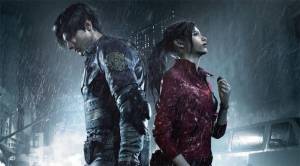
Fortunately, since the release of RE7 and Capcom’s implementation of the RE Engine, it seems like they’re back on track to becoming one of the best developers in the business. Despite a lot of the original staff having left over the years to pursue new ventures (such as director Hideki Kamiya who’s now at Platinum Games), the Resident Evil 2 remake remains remarkably faithful to the original vision from 1998’s classic. If you’re familiar with the inevitable downfall of Raccoon City and the trials of tribulations of rookie cop, Leon S. Kennedy, and “I’m searching for my brother, Chris” Claire Redfield, you’ll feel right at home here. The story is largely the same, but a few liberties have been taken (for the better mind you). Unlike the original PS1 game, the remake opts for a 3rd-person/over-the-shoulder perspective, which is more akin to post-RE4 titles and it works/feels as wonderfully as one would expect.

The core of the game and the general flow/structure mirrors the original title to a significant degree. At the same time, the Resident Evil 2 remake feels like a completely new experience. Capcom did a really good job balancing what made the 1998 game so great while adding modern sensibilities and other quality-of-life (QOL) changes. Each area is interconnected and outside of certain doors which still require keys, there are no load-screens between each location. Ink ribbons (at least on the standard difficulty) are no longer needed to save progress and auto-saves are generous in their usage. The map has even been made useful/relevant as items that have yet to be collected become noted and a simple color-coding scheme is applied showing the player whether or not a room has been completed looted. I completed Leon’s campaign on Standard difficulty and scored a “B” rank. Next is Clair’s campaign and I’ll likely save the higher difficulty and “S” rank runs for a later date.
Despite only logging on during seasonal events, I continue to play Blizzard’s Overwatch, perhaps against my better judgment. The Winter Wonderland 2018 and The Lunar New Year 2019 events launched late last year and in January of this year, respectively. Along with the most recent event came the “Year of the Pig”, which included a slew of new skins, emotes and the like (of which nothing of interest was unlocked, thanks to the dreaded RNG). I played as much of the game as I could despite having other ongoing game obligations and had just as much fun as I’ve had in previous events. I did walk away from the latest event with a new appreciation for the game, however. A weekly arcade mode, 8 Player Mystery Heroes FFA, was in rotation and it was specifically where I found myself playing the most.
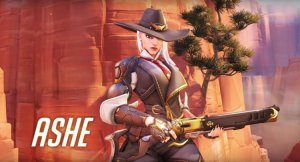
While I typically try to play/focus on a few specific characters, I wanted to see if this mode would be a quick opportunity to earn some easy loot boxes. What I quickly realized was how fun and easy it is to pick-up & play the majority of the roster. This death-match mode essentially forces you to play/try other characters at random upon death, which makes you learn whether or not one character or the other is built for your play-style. I went from exclusively playing as Soldier 76, Reaper and Pharah to wanting to potentially main Bastion, Ashe, Junkrat and possibly even Symmetra. Although I didn’t get any fancy new skins or emotes, I did come away from the past two events with a newfound appreciation for the game as a whole.
I also continue to play Bungie’s Destiny 2: Forsaken (begrudgingly mind you). Since the last time I wrote about my adventures with the Traveler, two major seasonal events have passed and I happened to participate in both of them. First, there was The Dawning, which had players collecting special ingredients in order to bake holiday-themed snacks & goodies for your fellow Guardians. Last month, we were gifted the glory that is Crimson Days, otherwise known as the yearly reminder that no one wants to play Crucible with you. I played Destiny 2 extensively during these two events and got all of the exclusive rewards/triumphs, too. The other major content update since last year has been the Black Armory and its accompanying Season of the Forge, which in retrospect, appeared to be divisive among fans. The Black Armory/Season of the Forge brought about new activities (specifically, the Forges), unique gear, a raid lair, a handful of triumphs and other quest-like pursuits.

From a story/lore perspective, I didn’t find the whole ordeal very captivating. At the same time, I’m not the most lore-invested Destiny player out there and I’ve yet to read beyond a couple of the lore entries I’ve unlocked since Forsaken (although I do plan on taking an afternoon to dive deeper one of these days). The forges themselves were horde-like/wave-based encounters where the objective was to dunk orbs dropped by powerful enemies into a central location. Various loot (with somewhat ridiculous drop rates) were gifted upon completion and the entire affair had players accepting/completing new bounties from the social space’s new debbie-downer, Ada-1. I came around to the forge activity itself and had my fun with it, but outside of that, the annual pass content continues to be another reason to login/grind towards an end-game I’m not sure I’ll ever experience. More thoughts on Destiny 2 and its current sixth season (Season of the Drifter) in the coming month…
Finally, I continue to play Capcom’s best-selling Monster Hunter: World. At this point, I feel relatively invested in the game and will likely shoot for the Platinum trophy (what’s another 150 hours?). The new expansion, Iceborne, is on its way too, which gives me plenty of time to work towards any remaining end-game quests/goals. Around the new year, Capcom released a quest or two to celebrate the arrival of 2019. In addition to this, the Appreciation Festival launched a month or so ago, which brought about new layered armor and other unique quests. I managed to score a handful of the exclusive gear during this event, but there’s still a bunch of end-game content I’m just not ready for. The recently announced Witcher 3 crossover event launched earlier this year too and it was much better than what most fans were expecting (complete with unique cut-scenes, quests and dialogue voiced by the original voice actor who played Geralt). More Monster Hunter: Stories (get it?) to come…
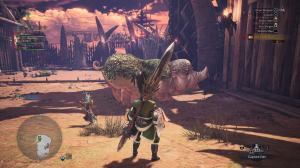
Here is a list of games I’ve started, stopped or checked-out since the new year. I don’t quite have the words ready for the games below, but you can look forward to reading my thoughts in the coming months.
PS4:
Nintendo Switch:
Nintendo 3DS:
Xbox One:
Until next quarter!
-Matty